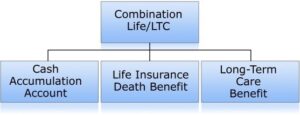Life insurance has many uses, including income replacement, business continuation, and estate preservation. Long-term care insurance helps provide financial protection against the potentially high cost of long-term care. If you find yourself in need of both types of insurance, a life insurance policy that combines a death benefit with a long-term care benefit may appeal to you.
Here’s how it works
Some life insurance issuers offer life insurance with a long-term care rider available for an additional charge and is subject to contractual terms, conditions, and limitations as outlined in the policy and may not benefit all people. If you buy this type of policy, you can pay the premium in a single lump sum or by making periodic payments. In any case, the policy provides you with a death benefit that you can also use to pay for long-term care expenses, should you incur them.
The amount of death benefit and long-term care allowance is based on your age, gender, and health at the time you buy the policy. The appeal of this combination policy lies in the fact that either you’ll use the policy to pay for long-term care expenses or your beneficiaries will receive the insurance proceeds at your death. In either case, someone will benefit from the premiums you pay.
Long-term care riders
The long-term care benefit is added to the life insurance policy by either an accelerated benefits rider or an extension of benefits rider.
Accelerated benefits rider
An accelerated benefits rider makes it possible for you to access your death benefit to pay for expenses related to long-term care. The death benefit is reduced by the amount you use for long-term care expenses, plus a service charge. If you need long-term care for a lengthy period of time, the death benefit will eventually be depleted. This same rider also can be used if you have a terminal illness that may require payment of large medical bills. Because accelerating the death benefit can have unfavorable tax consequences, you may want to consult your tax professional before exercising this option.
Example: You pay a single premium of $50,000 for a universal life insurance policy with a long-term care accelerated benefits rider. The policy immediately provides approximately $87,000 in long-term care benefits or $87,000 as a death benefit. If you incur long-term care expenses, the accelerated benefits rider allows you to access a portion, such as 3% ($2,610), of the death benefit amount ($87,000) each month to reimburse you for some or all of your
long-term care expenses. Long-term care payments are available until the total death benefit amount ($87,000) is exhausted (about 33.3 months).
Whatever you don’t use for long-term care will be left to your heirs as a death benefit.
(The hypothetical example is for illustration purposes only and does not reflect actual insurance products or performance. Guarantees are subject to the claims-paying ability and financial strength of the issuer.)
Extension of benefits rider
An extension of benefits rider increases your long-term care coverage beyond your death benefit. This rider differs from company to company as to its specific application.
Depending on the issuer, the extension of benefits rider either increases the total amount available for long-term care (the death benefit remains the same) or extends the number of months over which long-term care benefits can be paid. In either case, long-term care payments will reduce the available death benefit of the policy. However, some companies still pay a minimum death benefit even if the total of all long-term care payments exceeds the policy’s death benefit amount.
Continuing from the previous example, if the policy’s extension of benefits rider increases the long-term care benefit (the death benefit—$87,000—remains the same) to three times the death benefit ($261,000), the monthly amount available for long-term care increases to $7,830. On the other hand, if the extension of benefits rider extends the length of time the monthly long-term care benefit is available, then the monthly payments ($2,610) are extended for an additional 24 to 36 months beyond the initial number of months (33.3) available.
Other provisions
Typically, qualifying for payments under a long-term care rider is similar to the requirements for most stand-alone long-term care policies. You must be unable to perform some of the activities of daily living (bathing, dressing, eating, getting in or out of a bed or chair, toilet use, or maintaining continence) or suffer from a severe cognitive impairment.
An elimination period may also apply: You pay for the initial cost of long-term care out-of-pocket for a specific number of days (usually 30 to 90) before you can apply for payments under the policy. As with all life and long-term care insurance, the insurance company will require you to answer some health-related questions and submit to a physical examination before issuing a combination policy to you.
Is a combination policy right for you?
Deciding whether a combination policy is right for you depends on a number of factors. Do you need life insurance and long-term care insurance? How much life and long-term care insurance will you need? How long will you need it? Will the long-term care part of a combination policy provide sufficient coverage?
A long-term care rider may not provide as many features as a stand-alone long-term care policy. For example, the combination policy may not cover assisted living or home health aides. It also may not provide an inflation adjustment, an important feature considering the rising cost of long-term care. The tax benefits offered by a qualified long-term care policy may not apply to the long-term care portion of combination policies, which could result in taxation of long-term care benefits received from the policy.
What if your life insurance needs change as you get older and you find that you no longer want life insurance protection? It’s not uncommon for people to drop their life insurance in their later years if there’s no compelling need for it, but if you surrender the combination policy, you’re also forfeiting the long-term care benefit it provides, usually at a time when you are most likely to need it.
And keep in mind that as you use your long-term care benefits, you’re depleting the death benefit — a death benefit you presumably wanted to pass on to your heirs or perhaps use to pay estate taxes.
Finally, compare costs of combination policies to other forms of life insurance, such as term insurance, and stand-alone long-term care policies. Depending on your age and health, the cost for the combination life policy may actually be higher than the total premiums paid for separate life insurance and long-term care policies, especially if your life insurance need is temporary (such as income replacement during your working years) rather than permanent.
Example of Combination Permanent Life/LTC Policy Features

Content in this material is for general information only and not intended to provide specific advice or recommendations for any individual. All performance referenced is historical and is no guarantee of future results. All indices are unmanaged and may not be invested into directly.
The information provided is not intended to be a substitute for specific individualized tax planning or legal advice. We suggest that you consult with a qualified tax or legal professional.
LPL Financial Representatives offer access to Trust Services through The Private Trust Company N.A., an affiliate of LPL Financial.
This article was prepared by Broadridge.
LPL Tracking #1-05183378

